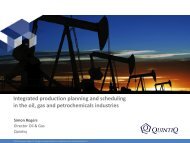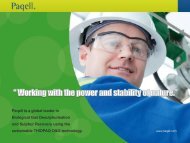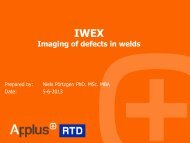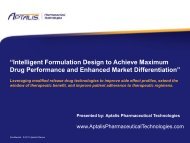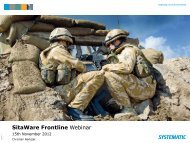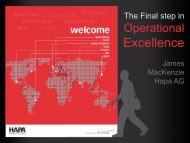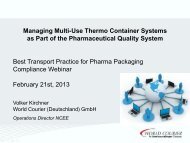Ozonolysis@LONZA - Business Review Webinars
Ozonolysis@LONZA - Business Review Webinars
Ozonolysis@LONZA - Business Review Webinars
You also want an ePaper? Increase the reach of your titles
YUMPU automatically turns print PDFs into web optimized ePapers that Google loves.
Continuous Flow Technology in Industrial Applications<br />
From lab to ton scale production featuring ozonolysis<br />
<strong>Business</strong> <strong>Review</strong> Webinar<br />
Dr. Dominique M. Roberge / November 9, 2011 / Webinar from Visp, Switzerland
Our extensive know-how and offering have<br />
evolved to meet customer needs<br />
Financially Stable / Global Footprint<br />
• CHF 2.7 billion (2010 sales)<br />
• 45 facilities; 11,000+ employees<br />
Focused on Life Sciences<br />
ces<br />
• Bioresearch<br />
• Pharma & Biotech<br />
• Nutrition<br />
• Personal Care<br />
Global leader in custom manufacturing<br />
• Chemical and biological APIs, cell therapy<br />
• Lead optimization through market supply<br />
10-Nov-11<br />
slide 2
•Our Visp, Switzerland site is home to<br />
numerous cutting-edge technologies<br />
Location<br />
• 150km east of Geneva<br />
• Footprint: t 90 hectares<br />
Fine Chemistry in Visp<br />
• Cracker for C2 supply<br />
• Continuously operating<br />
production (e.g. Niacin)<br />
• R&D, process development,<br />
small-scale production, and<br />
fine chemical complex FCC<br />
for pharma production<br />
• Large fermentation units<br />
Some key technologies<br />
• Large-Scale (10 m 3 ; total over 400 m 3 ),<br />
cGMP<br />
• cGMP phosgene plant<br />
• cGMP Continuous Ozonolysis<br />
10-Nov-11<br />
slide 3
Lonza Niacin<br />
• Continuous process from feed<br />
preparation to packaging<br />
• Manufactured under<br />
cGMP conditions<br />
• One dedicated facility in Visp,<br />
Switzerland<br />
• Thousand of tons per year<br />
O<br />
HNO 3<br />
OH<br />
N<br />
MEP<br />
N<br />
Niacin<br />
10-Nov-11<br />
slide 4
Pharma Production Campaign<br />
Production Duration Productivity Yield Unit operations Unit operations<br />
[t/a] [t/d] [%] reaction workup<br />
44 4-8 weeks 1.5 77 2.1 2.7<br />
Batch processes are:<br />
• Versatile (can deal with various phases: solid-liquid-gas; liquid and<br />
downstream operations: distillation, extraction…).<br />
• Flexible (can accommodate various reaction kinetics);<br />
Continuous processes are:<br />
• Efficient (bulk chemical industry).<br />
You need a combination of both Toolbox concept<br />
10-Nov-11<br />
slide 5
The Toolbox Concept: Modular Approach<br />
This a fundamental change in production strategy for the pharma<br />
and fine chemical industries.<br />
The toolbox concept enables to adapt a production unit to a<br />
chemical system.<br />
The ‘toolbox’ concept must be based on physical-chemical<br />
characteristics of the reaction such as:<br />
‣ Take into account the various kinetics and residence times.<br />
‣ The reaction phases (liquid–solid–gas).<br />
‣ Integration of mixing and heat exchange capabilities.<br />
‣ Avoiding dead volumes cGMP.<br />
10-Nov-11<br />
slide 6
Microreactors are at the heart of a<br />
dramatic shift in API production<br />
It enables continuous processes based on plug flow reactors with minimal volume<br />
of reagents, rapid dynamic responses and robustness, good temperature<br />
control, efficient mixing, etc.<br />
•outlet cooling<br />
•inlet i l t cooling<br />
•delay<br />
•loop<br />
•outlet product<br />
•inlet fluid 1<br />
•inlet fluid 2<br />
•outlet cooling<br />
•inlet cooling<br />
10-Nov-11<br />
•11 – 600 mL/min<br />
slide 7
All Lonza FlowPlate MicroReactors<br />
Development Reactor<br />
• View the chemistry<br />
• Reaction at tiny flow rates<br />
• Test different<br />
Production Reactor<br />
• Flexibility / versatility via different<br />
plates for unit operations<br />
• Design as key ingredient to<br />
scale-up<br />
• Multi-purpose<br />
•FlowPlate TM Lab<br />
•Plate Size: A6<br />
•Plate Size: A5<br />
•Channel structure<br />
•Sandmeyer Prize 2010<br />
10-Nov-11<br />
slide 8
Plate Design for Gas -<br />
Liquid Reactions<br />
Please refer to the webinar recording to view the video at:<br />
www.business-review-webinars.com/Lonza-Webinar<br />
i bi bi<br />
10-Nov-11<br />
slide 9
Lonza MicroReactor<br />
as Universal Modules<br />
Equipment Features<br />
• Modular, robust, over 100 bar<br />
• Hastelloy plates: process fluid<br />
• Aluminum plates: thermal fluid<br />
• Compactness, easy to adapt<br />
• Each plate = one specific<br />
design<br />
•1<br />
•22<br />
• 1 Plate for multi-injection<br />
• 2 Reactor system with 6<br />
plates<br />
• 3 A6 and A5 reactor systems<br />
•3<br />
10-Nov-11<br />
slide 10
Scale-up Concept with Lonza<br />
FlowPlate MicroReactors<br />
•FlowPlate<br />
•A++<br />
•Portable skid mounted<br />
units anywhere<br />
• Visp FCC<br />
• Nansha, China<br />
• Our customers<br />
•A6 •A5 •A4<br />
Laboratory System<br />
Flow labs fully integrated<br />
with kg-Labs<br />
Continuous SSP (MRT)<br />
Lonza pilot Unit<br />
Commercial Manufacturing<br />
Modular, flexible on skid mounted<br />
units<br />
1-150150 g/min<br />
150-600 g/min<br />
06 0.6- 5kg/min<br />
Few g to tens of kg<br />
0.1–5 tons campaigns<br />
5–80 tons campaigns<br />
- Your green and - Plugging issues solved<br />
- Fully automated<br />
sustainable process of - Accelerated development at<br />
tomorrow<br />
lower costs<br />
-Fit for any scale<br />
- Streamlined and simplified processes<br />
- Drastic reduction in costs of goods<br />
10-Nov-11<br />
slide 11
Handling Unstable Reaction Intermediates:<br />
From lab to ton scale production featuring ozonolysis<br />
Dr. Markus Nobis / November 9, 2011 / Webinar from Visp, Switzerland
Structure<br />
• About Lonza<br />
• Ozone – some facts and requirements<br />
• Ozonolysis @ Lab scale<br />
• Development of an Ozonolysis / Risk assessment<br />
• Ozonolysis @ Production scale /example<br />
• Future concept<br />
10-Nov-11<br />
slide 13
Ozone –<br />
some facts<br />
• Ozone<br />
• Gaseous Oxidant, characteristic smell<br />
• Bp.: -112°C (liquid: deep intense blue)<br />
• Not storable - has to be generated on site<br />
• How to generate<br />
• Ozone generation is carried out via silent electric<br />
discharge in the presence of dried oxygen or air<br />
10-Nov-11<br />
slide 14
Ozonolysis -<br />
Important Facts<br />
• Ozone: Toxic due to the oxidative potential.<br />
• Ozonides/Alkoxyhydroperoxides: Sometimes less stable<br />
intermediates in the liquid phase.<br />
• Aerosoles: Possibility of explosive mixtures of substrate droplets,<br />
Oxygen and Ozone in the headspace over the reaction solution<br />
slide 15
Ozonolysis on technical scale -<br />
Why use Ozone as an Oxidant?<br />
• One of the best reagents to obtain carbonyl compounds directly<br />
from unsaturated compounds<br />
• High atom efficiency<br />
• Equal number of unit operations<br />
• Lower reagent and waste treatment costs<br />
• Comparable development costs to other chemical transformations<br />
10-Nov-11<br />
slide 16
Ozonolysis -<br />
Chemical Platform<br />
R<br />
N<br />
COOH<br />
COOH<br />
US Appl. 20030216577<br />
R<br />
N<br />
COR'<br />
COOH<br />
R<br />
COOR<br />
n<br />
Unsaturated Esters<br />
Aromatic<br />
Carboxylic Acids<br />
O<br />
X<br />
Oxides<br />
WO / 2009 / 014431<br />
R<br />
n<br />
O<br />
O<br />
O<br />
Isolable Ozonides<br />
R<br />
X<br />
N<br />
X=PR, NR, S<br />
R<br />
R<br />
O<br />
Nef-Reaction<br />
R'<br />
Ozone<br />
NO 2<br />
n<br />
R<br />
R'<br />
n<br />
R<br />
R''<br />
OH<br />
R'' R'<br />
R<br />
n CH 2 OH<br />
Alcohols<br />
O<br />
Aldehydes, Ketones<br />
US Appl. 20060224019<br />
US Appl. 20080319232<br />
R<br />
R<br />
n<br />
R<br />
R<br />
n<br />
CHO<br />
Unsaturated Aldehydes<br />
R<br />
HO<br />
R<br />
O<br />
n<br />
O<br />
COOR<br />
Carboxylic Ester<br />
R<br />
n<br />
Aldehyde<br />
CHO<br />
OH<br />
Carbon acids<br />
R EP 2 060 556 A1<br />
Schreiber et al.<br />
slide 17
Ozonolysis in industrial applications -<br />
Laboratory requirements for scale up activities<br />
• Reaction parameters: High flexibility of the setup required to allow the<br />
fast adoptions to new process conditions (Ozonolysis and Downstream<br />
Processing)<br />
• Reaction volume: Capability to handle different product volumes; ideally<br />
with the same flow device.<br />
• Materials: Compatibility to process conditions<br />
• Data: Fast and reliable access to necessary information for safety assessment<br />
directly out of the process development Short time to launch<br />
►Solution: Flow technology and microreactor<br />
technology (MRT)<br />
10-Nov-11<br />
slide 18
Ozonolysis in industrial applications -<br />
Requirements on technical scale<br />
• Risk assessment: Periodical risk assessment of the<br />
production train in addition to the project related risk<br />
assessment<br />
• Ozone Injection: Minimization of the potential risk regarding<br />
aerosoles by the applied system for the Ozone injection<br />
• Chemistry / Process: Optimization of the reaction conditions<br />
to minimize the Ozone content in the vented Offgas<br />
• Ozonides: Clear understanding about the technical handling<br />
and chemical behaviour of the unstable intermediates<br />
• Staff: Extensive training (periodically and project related)<br />
slide 19
Ozonolysis at Lab scale
Ozonolysis -<br />
Approach the process in 4 steps with novel flow concepts<br />
Requirement<br />
Perfect control of the process on technical scale<br />
•Feasibility Access the molecule<br />
•Development Define the essential parameters<br />
•Tech transfer Implement the process on technical scale<br />
•Production Applicaton of the process<br />
Feasibility Development Tech transfer Production<br />
10-Nov-11<br />
slide 21
Feasibility Development Tech transfer Production<br />
Ozonolysis –<br />
Flow concept for the fast initial testing - requirements<br />
• Reaction / Chemistry<br />
• Selectivity Idea about the requirements<br />
• Downstream processing Initial idea about the targeted<br />
Molecule, limiting factors<br />
• Knowledge about safety critical points e.g. Aerosoles<br />
• System/Equipment<br />
• Flexible set-up to allow fast change over to other reaction<br />
conditions (e.g. small scale flow/MRT)<br />
• Capability of the set-up to generate fast and reliable data<br />
regarding g important parameters of the reaction<br />
• First scale up capabilities screening of DSP<br />
• Possibility for the fast implementation of different work-up<br />
conditions<br />
10-Nov-11<br />
slide 22
Feasibility Development<br />
TechTransfer Production<br />
Ozonolysis in flow –<br />
Concept for fast initial testing and fast development<br />
• Four key components<br />
• Fast change over<br />
Offgas<br />
• Flexible work up design:<br />
Flow / MRT / Batch<br />
• Flexible operation:<br />
batch vs. conti mode<br />
• Scale-up: mimicing production<br />
scale- up to multigram scale<br />
Reaction<br />
Ozone<br />
Balancing<br />
Dedicated Laboratory for<br />
Ozonolysis development<br />
Ga as<br />
sepa arator<br />
Pump<br />
Ozo one<br />
Injec ction<br />
O3-<br />
Generator<br />
Air/Oxygen<br />
3O 2 →2O 3<br />
Feed<br />
10-Nov-11<br />
Downstream<br />
Reaction<br />
M.Nobis, D.Roberge, Chemistry Today, vol.29 n.1 January/February 2011<br />
upstream<br />
slide 23
Development of an Ozonolysis:<br />
Fast R&D and transfer to production scale
Feasibility Development Techtransfer Production<br />
A concept for fast development and implementation<br />
• Aim 1: Identification of essential parameters<br />
• Safety Critical parameters<br />
• Quality determining parameters<br />
• Aim 2: Implementation of improvement potential<br />
• Ozone efficiency Minimum target: >95%<br />
• Temperature regime Target: avoidance of cryogenic conditions<br />
• Ozone concentration Target: 80-90% of the possible range<br />
• Substrate concentration high/low<br />
• Change of the process operation mode: Discontinuous/continuous<br />
Capability to apply the tailored solution<br />
• Possibilities for the application of different scales<br />
(1-5 gram 100grams scale) with the same device!<br />
• Mimicing i i of production system in R+D (!)<br />
10-Nov-11<br />
slide 25
Development of an Ozonolysis:<br />
Risk Assessment
Feasibility Development Techtransfer Production<br />
Ozonolysis Risk Assessment<br />
• Safety studies: Proof of<br />
• Stability of the intermediates<br />
• Robustness of the down stream<br />
processing procedure<br />
• Integrated part in R&D activities<br />
@Lonza:<br />
Generation of the process safety<br />
data package:<br />
• DSC / RC-1/ Miniautoclave<br />
• Thermal decomposition of<br />
intermediary stages and products<br />
Definition of technical Measurements for<br />
the safe handling of the Ozonolysis<br />
process<br />
Re-assessment in case of a change of<br />
the reaction conditions!<br />
10-Nov-11<br />
slide 27
Feasibility Development Techtransfer Production<br />
Ozonolysis Risk Assessment<br />
• Chemistry<br />
• Solvents<br />
• Reduction/oxidation agent<br />
• Accumulation of reaction potential during<br />
work-up<br />
• Autocatalytic ability in case of Ozonide<br />
degradation<br />
• Process<br />
• Concentration of the Ozonide in solution:<br />
Risk of dry-out/precipitation (mech. stress!)<br />
• Consideration of potential thermal stress on<br />
the ozonation process on scale (hot spots<br />
during oxidation/reduction)<br />
• Quench as safety fall back option?<br />
• Compatibility of materials<br />
• Materials in contact with Ozone and<br />
ozonation products<br />
• Compatibility of sealing and gasket materials<br />
10-Nov-11<br />
slide 28
Feasibility Development Techtransfer Production<br />
Ozonolysis Risk assessment – waste treatment<br />
• Handling of Ozone containing gas streams<br />
• Risk assessment regarding destruction of<br />
Ozone content:<br />
• Catalytical destruction<br />
• Thermal destruction<br />
• Scrubbing<br />
Measurements in case of technical failure<br />
• Handling of waste streams from downstream<br />
processing<br />
• Aqueous waste streams: biological vs.<br />
thermal treatment (e.g. scrubber solutions)<br />
• Judgement about harzards ards deriving ing from<br />
mixing waste streams with other waste<br />
streams (Reactivity)<br />
• Organic waste streams (distillates / side<br />
streams)<br />
10-Nov-11<br />
slide 29
Feasibility Development Techtransfer Production<br />
Ozonolysis @ Production scale:<br />
The technical implementation using flow chemistry
Feasibility Development Techtransfer Production<br />
<strong>Ozonolysis@LONZA</strong><br />
Ozonolysis Production train<br />
• Dedicated production train for conversions<br />
with Ozone<br />
• Ozonolysis can be carried out under<br />
temperature conditions down to -80°C<br />
• Capacity: 8.5 Kg Ozone/hour<br />
• Ozonolysis is carried out in a contained<br />
loop-reaction system (Reactor Volume<br />
450L)<br />
• Kg to mT-scale possible due to operability<br />
under discontinuous to continuous process<br />
conditions<br />
• Trained team for the ozonolysis<br />
slide 31
Feasibility Development Techtransfer Production<br />
<strong>Ozonolysis@LONZA</strong><br />
Production capabilities – technical environment<br />
• Ozonolysis @ Lonza is fully embedded d in the technical and regulatory<br />
environment of an multipurpose facility<br />
• broad range of up- and downstream processing methodologies!<br />
• Flexible concept of the facility<br />
• allows to switch the down stream processing from discontinuous<br />
to continuous mode<br />
Disconti / batch<br />
Conti<br />
slide 32
Feasibility Development Techtransfer Production<br />
Ozonolysis at Production Scale:<br />
Example
Feasibility Development Techtransfer Production<br />
Ozonolysis@Lonza<br />
Ozonolysis of Chrysanthemic acid methylester<br />
RO<br />
O<br />
Ozone<br />
Reduction<br />
RO<br />
O<br />
O<br />
Feasibility Development Techtransfer Production<br />
10-Nov-11<br />
slide 34
Feasibility Development Techtransfer Production<br />
Ozonolysis at LONZA<br />
Future concepts
Feasibility Development Techtransfer Production<br />
Ozonolysis@Lonza:<br />
Downstream processing - MRT and Continuous Flow<br />
• New Concepts:<br />
• Focus on the downstream processing:<br />
• Application of catalysis and environmentally friendly<br />
methodologies<br />
Ozonid<br />
Ozonid/<br />
H 2<br />
Cat<br />
Product<br />
Ozonid<br />
H 2<br />
NaBH 4 (aq)<br />
10-Nov-11<br />
• Tunable Specifity:<br />
• Change of the selectivity due to the change of the process<br />
conditions<br />
• Processing of the primary ozonation products:<br />
• Flow and micro / meso structured devices for the efficient<br />
mass and heat transfer<br />
slide 36
Feasibility Development Techtransfer Production<br />
Ozonolysis@Lonza<br />
Downstream processing - MRT /Continuous Flow (II)<br />
• Innovation: optimization of the Downstream processing (DSP)<br />
• Include more eco-friendly conversions in the DSP<br />
• Capability based on the MRT/microstructured devices:<br />
Oxidation with Oxygen under pressurized conditions<br />
• Homogeneous oxidation of Ozonides via MRT to carbon<br />
acids<br />
Ozonide<br />
Ozonide/<br />
H 2 O2<br />
Carbon<br />
Ozonide<br />
H 2 O 2<br />
acid<br />
NaOH(Aq)<br />
O 2<br />
slide 37<br />
10-Nov-11
Feasibility Development TT Production<br />
Summary<br />
• Ozone can be advantageously applied for the clean Oxidation of different<br />
unsaturated starting materials<br />
• Development of the Ozonolysis process requires the same or less number of<br />
unit operations compared to other oxidation protocols<br />
• Ozonloysis can be handled safe, even on large scale – risk assessment has<br />
to be carried out to define the required measurements<br />
• Flow chemistry and MRT allows the fast and flexible development and scaleup<br />
to productions scale<br />
• Ozonolysis@Lonza: dedicated train for the ozonolysis production; high<br />
flexibility of the plant set-up allows us to switch operation mode (semi<br />
batch/conti) t if required<br />
ed<br />
slide 38
Thank you for your attention
Back-up slides
Toxicity of Ozone<br />
slide 41
Chemistry – Involvement of Solvents into the Ozonide<br />
• Criegee Mechanism<br />
slide 42




